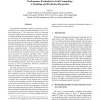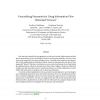209 search results - page 8 / 42 » Using Run-Time Data for Program Comprehension |
IWPC
2005
IEEE
14 years 1 months ago
2005
IEEE
Source code can be viewed in many ways, with each view facilitating access to different information contained within the code. In this working session, we will explore the role th...
CCGRID
2007
IEEE
14 years 2 months ago
2007
IEEE
Experimental performance studies on computer systems, including Grids, require deep understandings on their workload characteristics. The need arises from two important and closel...
COGSCI
2004
13 years 7 months ago
2004
Disfluencies include editing terms such as uh and um as well as repeats and revisions. Little is known about how disfluencies are processed, and there has been next to no research...
EUROSYS
2007
ACM
14 years 5 months ago
2007
ACM
Dryad is a general-purpose distributed execution engine for coarse-grain data-parallel applications. A Dryad application combines computational “vertices” with communication �...
LICS
2005
IEEE
14 years 1 months ago
2005
IEEE
Run-time type analysis allows programmers to easily and concisely define operations based upon type structure, such as serialization, iterators, and structural equality. However,...


